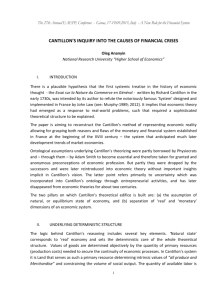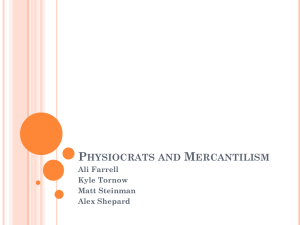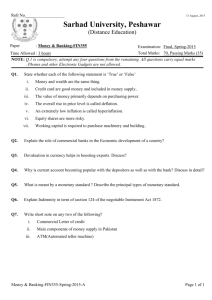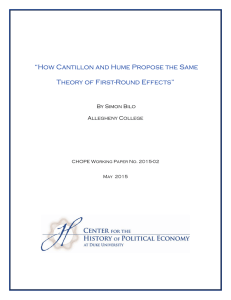AnanyinGenoa15
advertisement
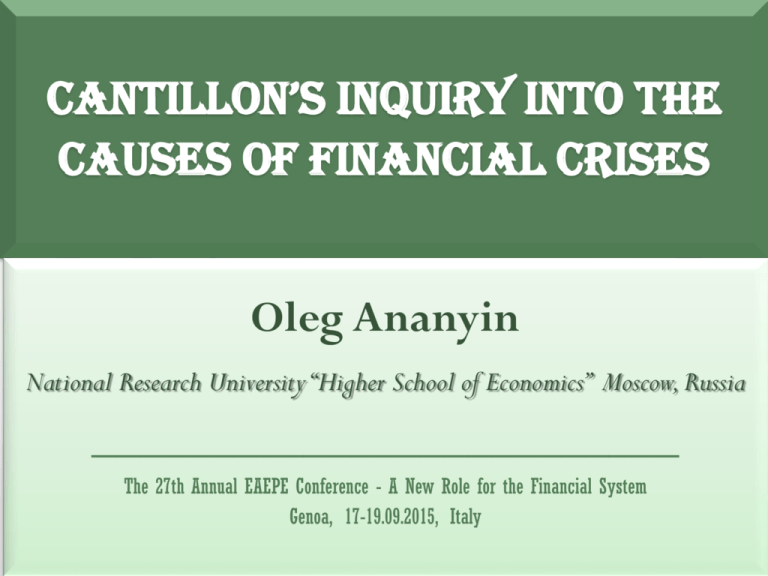
CANTILLON’S INQUIRY INTO THE CAUSES OF FINANCIAL CRISES Oleg Ananyin National Research University “Higher School of Economics” Moscow, Russia _________________________ The 27th Annual EAEPE Conference - A New Role for the Financial System Genoa, 17-19.09.2015, Italy “…[L]ike Beckett's Godot, while Law never appears in the Essai, both he and the System are ever present” (Antoin Murphy) • “Having outlined his understanding of the economic system, Cantillon then tested his model to see whether it would accept or reject the new grafts that John Law applied to it. o Was the basic underlying model capable of accepting a new credit system based on paper money? o Could it be stimulated through monetary expansion? … o Could it be manipulated through the use of exchange rate policy? • As such the strong secondary objective of the Essai was to provide a critique of Law and his System”. (Antoin Murphy, 1989) Why Cantillon? • There is a remarkable testimony of Victor de Riqueti, marquis de Mirabeau, the co-author of Francois Quesnay and co-initiator of Physiocratic school of classical economics: “One man conceived and explained the Tableau portraying the source, the course and the effects of circulation, to make it the core and the foundation of economic science, and the compass for the governing of states. Another developed the fruit of the tree of life and presented it to humanity...” • The context of this testimony suggests that by “Another [man]” Mirabeau means F. Quesnay. If so, there remains no other candidate for “one man conceived and explained the Tableau [économique]… to make it… the foundation of economic science”, but Richard Cantillon. • To assess the range of the issue a known fact of major influence of Quesnay’s ideas on Adam Smith should also be kept in mind. Who is Cantillon? • Date of birth: unknown (1680 – 1690 – 1697 - ?) • Place and date of death: shrouded in mystery (Cantillon’s house in London was burnt down in 1734, and a charred corpse was found in it... Whose corpse? – Of Cantillon, up to official version… • But some later Cantillon’s documents were found in Surinam, and there remained a mysterious story about a gentlemen arrived to Paramaribo and disappeared without a trace just after arrival … • Cantillon’s manuscript “Essai sur la Nature du Commerce en Général”: was published anonymously in 1755 in French: allegedly in London (as pointed at the title page), or in Paris, as experts tend to think; allegedly translated from English (but English original is not found) without statistical Supplement (mentioned in the main text) Some additional facts • A banker and merchant, beneficiary of great bubbles of 1720; • Highly influential in the formative period from 1750s to 1770s (appreciated, among others, by Quesnay, Turgot, Condillac, sir James Steuart, and Adam Smith); no less valued by plagiarists; • Later forgotten, almost entirely (with few exceptions, including Karl Marx); • Rediscovered in 1881 by W.S. Jevons, one of the founders of modern economics, who defined Cantillon’s Essai ‘the cradle of political economy’. Two pillars • The two pillars on which Cantillon’s theoretical edifice is built are: (a) the assumption of natural, or equilibrium state of economy; (b) separation of ‘real’ and ‘monetary’ dimensions of an economic system. Natural state I. An equilibrium, or natural state is conceived as a characteristic of an objective circular flow process predetermined independently of market forces; II. Market forces pushing the system towards the natural equilibrium state are assumed to be driven by humans and therefore imperfect with various sources of uncertainty ever present to cause deviations (from natural state); III. Natural state is explained without not only any recourse to ‘invisible hand’, but without normative connotations as well: equilibrating trend is taken to be natural, yet ‘blind’. Basic deterministic model “The Fancies, the Fashions, and the Modes of Living of the Prince, and especially of the Landowners, determine the use to which Land is put” Landlord’s manners Adaptive human fertility LAND FERTILITY ‘Three rents theory’ as a fully determined wealth production scheme: by land fertility by consumption customs of people by landlords (unstable) manners by human (adaptive) fertility “The Number of Labourers, Handicraftsmen and others, who work in a State is naturally proportioned to the Demand for them” PRODUCTION of WEALTH Non-identity of natural and normative normative natural “It does not appear that Providence has given the Right of the Possession of Land to one Man preferably to another: the most ancient titles are founded on Violence and Conquest… But howsoever people come to the property and possession of Land we have already observed that it always falls into the hands of a few in proportion to the total inhabitants” … the Number of Inhabitants of a State depends on the Means allotted them of obtaining their Support; and as this Means of Subsistence arises from the Method of cultivating the soil, and this Method depends chiefly on the Taste, Humours and Manner of Living of the Proprietors of Land, the Increase and Decrease of Population also stand on the same Foundation “If a Proprietor or Nobleman in Poland, to whom his Farmers pay yearly a Rent equal to about one third of the Produce of his Land, pleases to use the Cloths, Linens, etc. of Holland … there will be a good third of the produce of the Land in Poland abstracted from the Food of the People, and, what is worse, mostly sent to the Foreigner and often serving to support the Enemies of the State” natural normative Market as a locus of uncertainty “There is never a variation in intrinsic values, but the impossibility of proportioning the production of merchandise and produce in a State to their consumption causes a daily variation, and a perpetual ebb and flow in Market Prices”; It is here that an entrepreneur enters the game. The market mechanism is driven by various types of middlemen-entrepreneurs responsible for the adaptation of production possibilities to changing manners of the final consumers; The mechanism is not assumed to work smoothly: “It often happens that Sellers who are too obstinate in keeping up their price in the Market, miss the opportunity of selling their Produce or Merchandise to advantage and are losers thereby”; In more general terms: “[the] method of fixing Market prices has no exact or geometrical foundation, since it often depends upon the eagerness or easy temperament of a few Buyers or Sellers, it does not seem that it could be done in any more convenient way”. Monetary system as a locus of manipulations Exchange economy is conceived by Cantillon as monetary, and all deviations from ‘natural state’ take therefore monetary form. They are caused: • either by imperfections in entrepreneurs’ responses to market demand, or • by harmful monetary regulations. In each case these deviations have human origin. However, unlike entrepreneurs’ failures for which they are fully responsible, effects of monetary regulations are due to governmental, or power, agencies and tend to charge burden on a broader public. Two spheres of manipulations • Cantillon considers two spheres where manipulations could be observed: o manipulations with exchange rates under bi-metallic monetary regimes; o what he calls ironically “refinements of credit” – practices became known during Great Bubbles of the early XVIII century, including that of Law’s ‘System’ Bi-metallic system manipulations • Cantillon presents careful analysis of “strange variations” of price levels occurred in France and caused by conscious manipulations of exchange proportions between gold and silver, explains their effects upon foreign trade and income distribution. • His conclusion: “The King makes a considerable profit…, but it costs France three times as much to enable him to make this profit” Regulations under Great Bubbles Cantillon’s method is the same: he defines the channels through which human agents – in this case governmental agencies – influence economic processes, and indicates limits of this influence. In relation to John Law’s system it was the introduction of a public bank that created new instruments of manipulations. Cantillon showed that financial innovations led to a widening of the gap between the natural state and actual state of affairs. His final conclusion was straightforward: Real/monetary dichotomy It is … undoubted that a Bank with the complicity of a Minister is able to raise and support the price of public stock and to lower the rate of interest in the State at the pleasure of this Minister when the steps are taken discreetly, and thus pay off the State debt. But these refinements which open the door to making large fortunes are rarely carried out for the sole advantage of the State, and those who take part in them are generally corrupted. The excess banknotes, made and issued on these occasions, do not upset the circulation, because being used for the buying and selling of stock they do not serve for household expenses and are not changed into silver. But if some panic or unforeseen crisis drove the holders to demand silver from the Bank the bomb would burst and it would be seen that these are dangerous operations. Interventions (i.e. deviations from natural state): possible, yet corrupted Real & monetary economies as relatively separated Limits of real/monetary separation Cantillon’s legacy • In order to reveal the flaws of Law’s ‘System’ Cantillon had to construct a theoretical structure which laid the groundwork for future developments of economic theories. The idea of the circular flow of social product became the core of the famous ‘Tableau Économique’. The idea of ‘immutable laws of production’ (J.S. Mill’s term) as a kind of benchmark around which actual economic activities tend to gravitate served the common ground to both Classical political economy and much of neoclassical theorizing. Dichotomy of real/monetary phenomena, Knightian entrepreneurs, Pasinetti’s pre-institutional framework of economic analysis, – all these concepts and approaches have their evident predecessors in Cantillon’s Essai. • Recent theories of financialization can also be traced back to Cantillon’s analysis of “the refinements of credit”. He was the first to show that a financial system is such a superstructure over ‘real’ economy that might be treated as ‘neutral’ only in the abstract, and is misleading being applied to the real world. Assessing experiences of Great Bubbles Cantillon became aware of the possibility that a financial system inhabited with people pursuing their private purposes can acquire certain – although limited – degree of independence from the ‘real’ sector as its base, and perceived this possibility to be socially dangerous.
